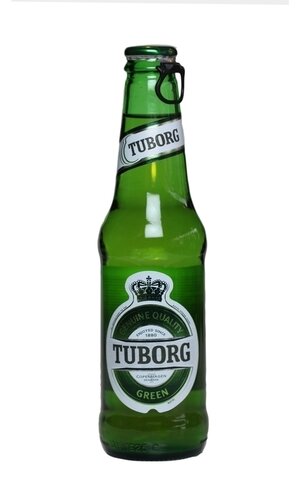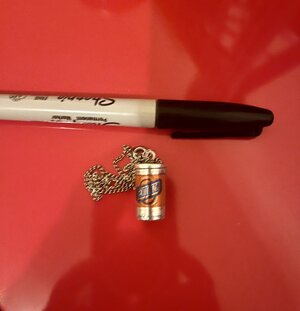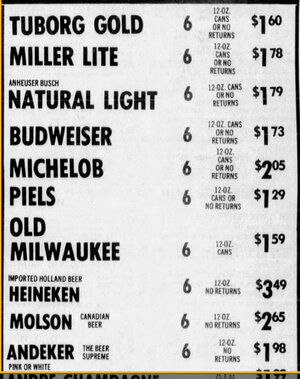Navigation
Install the app
How to install the app on iOS
Follow along with the video below to see how to install our site as a web app on your home screen.
Note: This feature may not be available in some browsers.
More options
You are using an out of date browser. It may not display this or other websites correctly.
You should upgrade or use an alternative browser.
You should upgrade or use an alternative browser.
"Nine Beers Americans No Longer Drink"
- Thread starter donbosco
- Start date
- Replies: 122
- Views: 3K
- Off-Topic
fourheels
Honored Member
- Messages
- 911
You are correct. Buffett mentions Tuborg in "Miss You So Badly" off of 1977s Changes in Latitudes, Changes in Attitudes album. It was the B-side track of "Margaritaville".Tuborg was 1.29 a six at Fowlers in 1974.To our distress it went up to 1.39 next year. Tuborg got a mention in a Jimmy Buffet song,iirc
Anybody have any cans of Billy Beer in the basement?
superrific
Master of the ZZLverse
- Messages
- 10,899
I do not. My brother does. I stock up when I visit him. I guess I shouldn't have said "local dispensary" but I was trying for a parallel structure to the post I responded to.Obviously you live in Michigan. Other legal weed states aren’t nearly as cheap. That’s why the black market continues to thrive.
Google tells me that Michigan's prices are not lower than many other states. Higher than Illinois? well, of course. But everything is higher in Illinois. Eh, I shouldn't speak as if I know much about the national cannabis market; I definitely do not.
Is it fair to say that weed is much more cost-effective per unit of intoxication than beer?
I would certainly think so and I'm limited to stuff that qualifies under the Farm Bill although the THCa products are pretty good. I got an ounce of bud a couple of weeks ago that the lad analysis said was 42% TCA. I think that when it converts, around 91% becomes THC. I paid 140 bucks delivered to my mailbox. Been smoking it regularly for a month and still have 60% left.I do not. My brother does. I stock up when I visit him. I guess I shouldn't have said "local dispensary" but I was trying for a parallel structure to the post I responded to.
Google tells me that Michigan's prices are not lower than many other states. Higher than Illinois? well, of course. But everything is higher in Illinois. Eh, I shouldn't speak as if I know much about the national cannabis market; I definitely do not.
Is it fair to say that weed is much more cost-effective per unit of intoxication than beer?
I can also get a 25 gram block of THCa diamonds for a little less than that that is sold as 99+% pure. Since they have to be licensed by the state and are shipping by USPS, I tend to buy into the theory that mail fraud is a practical business theory with so little to gain. I do know that both work extremely well, at least in combination.
superrific
Master of the ZZLverse
- Messages
- 10,899
You are a much more hard core user than me. I don't even know what you're talking about with half this stuff.I would certainly think so and I'm limited to stuff that qualifies under the Farm Bill although the THCa products are pretty good. I got an ounce of bud a couple of weeks ago that the lad analysis said was 42% TCA. I think that when it converts, around 91% becomes THC. I paid 140 bucks delivered to my mailbox. Been smoking it regularly for a month and still have 60% left.
I can also get a 25 gram block of THCa diamonds for a little less than that that is sold as 99+% pure. Since they have to be licensed by the state and are shipping by USPS, I tend to buy into the theory that mail fraud is a practical business theory with so little to gain. I do know that both work extremely well, at least in combination.
All I know is that I've never been able to get a buzz so cheaply in my whole life, and the whole concept of "cheap beer" seems misplaced in an era of cheap weed. I mean, the shitty beer costs more AND you have to drink it.
- Messages
- 3,181
Are you referring to Tudor beer in the wide mouth bottle ?I miss Fowlers Not so much Tuborg
It usually sold for around $1.15/six pack but sometimes you could buy it for 99 cents.
It was the go to beer for my peer group. We agreed that after drinking 4 or 5 beers, all beers tasted the same so why not buy the cheapest.
fourheels
Honored Member
- Messages
- 911
No. See my response to his post above.Are you referring to Tudor beer in the wide mouth bottle ?
It usually sold for around $1.15/six pack but sometimes you could buy it for 99 cents.
It was the go to beer for my peer group. We agreed that after drinking 4 or 5 beers, all beers tasted the same so why not buy the cheapest.

- Messages
- 3,181
Ok then...
I don't remember seeing that beer at Fowler's so I'm guessing that if I did see it, I took a pass because Tudor was cheaper
Does anyone else remember the "Schlitz challenge" that came to Chapel Hill one weekend in either the fall of 1980 or 1981? At least one iteration of it was staged in the parking lot of Fraternity Court. You drank samples of two unmarked beers and voted for your favorite. I think the beer being tasted against Schlitz was Michelob [but don't remember for sure]. Schlitz was prepared with an ad campaign saying something like X% of Chapel Hill beer drinkers preferred Schlitz over Michelob. The count as I remember was something like 80/20 preferring Michelob. What I don't remember is whether Schlitz went through with the planned ad.It took a lot of bad management to ruin the Schlitz brand. A lot. From Wikipedia
n 1953, Milwaukee brewery workers went on a 76-day strike. The strike greatly impacted Schlitz's production, including all of Milwaukee's other breweries and allowed Anheuser-Busch to surpass Schlitz in the American beer market. The popularity of Schlitz's namesake beer, along with the introduction of value-priced Old Milwaukee, allowed Schlitz to regain the number-one position. Schlitz and Anheuser-Busch continued to compete for the top brewery in America for years.
By 1967, the company's president and chairman was August Uihlein's grandson, Robert Uihlein Jr. Faced with a desire to meet large volume demands while also cutting the cost of production, the brewing process for Schlitz's flagship Schlitz beer was changed in the early 1970s. The primary changes involved using corn syrup to replace some of the malted barley, adding a silica gel to prevent the product from forming a haze, using high-temperature fermentation instead of the traditional method, and also substituted less-expensive extracts rather than traditional ingredients. Schlitz also experimented with continuous fermentation, even building a new brewery specifically designed to use the process in Baldwinsville, New York. The reformulated product resulted in a beer that not only lost much of the flavor and consistency of the traditional formula, but also spoiled more quickly, rapidly losing public appeal.
In 1976, concern was growing that the Food and Drug Administration would require all ingredients to be labeled on their bottles and cans. To prevent having to disclose the artificial additive of the silica gel, Uihlein switched to an agent called "Chill-garde" which would be filtered out at the end of production, so it would be considered nondisclosable. The agent reacted badly with a foam stabilizer that was used and Schlitz recalled 10 million bottles of beer, costing it $1.4 million. Schlitz was further hurt by the rise of high-volume light beers such as Miller Lite and Bud Light, a direction Schlitz did not aggressively pursue – although James Coburn appeared in commercials for the short-lived Schlitz Light in 1976.
As part of its efforts to reverse the sales decline, Schlitz launched a disastrous 1977 television ad campaign created by Leo Burnett & Co. In each of the ads, an off-screen speaker tries to convince a Schlitz drinker to switch to a rival beer. The Schlitz drinker then talked about how they would never switch and jokingly threatened the person trying to persuade them away from their favorite beer. Despite the tone of the campaign intending to be comedic levity, audiences found the campaign somewhat menacing and the ad industry dubbed it "Drink Schlitz or I'll kill you." Schlitz, unwilling to endure more bad press, pulled the campaign after 10 weeks and fired Burnett.
***
They didn't test the chill-garde and foam stabilizer before bottling it? WTF?
donbosco
Legend of ZZL
- Messages
- 5,216
donbosco
Legend of ZZL
- Messages
- 5,216
Ok then...
I don't remember seeing that beer at Fowler's so I'm guessing that if I did see it, I took a pass because Tudor was cheaper
The Tuborg that I remember was in a brown bottle...'round 1978 or so. There was a Viking ad campaign.
- Messages
- 3,604
I moved a sixpack of Billy Beer more times that I care to count. Eventually a couple of the cans started to balloon and I tossed them out before they exploded.Anybody have any cans of Billy Beer in the basement?
- Messages
- 3,181
don't know about Tuborg but Tudor did come in a brown bottle with a wide mouth opening. We liked the wide mouth because it made it easy to guzzleThe Tuborg that I remember was in a brown bottle...'round 1978 or so. There was a Viking ad campaign.
CRHeel94
Honored Member
- Messages
- 812
I did a summer internship at Miller back in the 90s. I'm not surprised to see so many Miller brands on a list that's ten years old. The merger with Coors led to them shifting their focus to other things, but they were already in trouble.
MGD use to be a great brand. Product was okay. Always felt like Miller High Life was the overlooked product. Some of those other products sucked ass.
I got 3 cases of beer per month that summer as well as access to their on-site bar (which was emptier than you'd imagine).
MGD use to be a great brand. Product was okay. Always felt like Miller High Life was the overlooked product. Some of those other products sucked ass.
I got 3 cases of beer per month that summer as well as access to their on-site bar (which was emptier than you'd imagine).
Centerpiece
Inconceivable Member
- Messages
- 2,968
Tend to agree with the distinction... But that’s why I qualified my comment with “was” And: “like Budweiser”.Just a distinction here… Cheap American domestic beer has never been of the quality of inexpensive beer you’d find in Europe. But as for “American beer…” as a whole, that was only true in the ‘80s when you lived there, but not for much longer afterward. By the late ‘90s early ‘00s, the whole beer brewing world was playing catch-up, chasing American craft brewers and trying to imitate their beers (and mostly failing).
Since that boom, with very few exceptions, we have examples of nearly every style imaginable that are on par with the best old-world brewers. And many newer styles that nobody else even comes close to. In every US region and in most locales.
And many of those old-world brewers would tell you that themselves.
I live a stones throw from Fonta Flora, one of the most prestigious, award winning craft breweries in NC. Small batch baby!
But I’ll stand by my original comment: “American beer like Budweiser is/was total shite.”
- Messages
- 1,971
Seeing that green bottle of Tuborg and a mention of Fowlers put me in mind of a beer we used to drink a lot of, but I haven't seen in a long time: Little Kings. Do they still make that anymore? The discussion of Guiness put me in mind of Thursday nights at Molly's (was there a name for it? International Night? I can't remember) where the exotic-at-the-time black and tans were the specialty of the evening. I still enjoy a Guiness, but mostly in the winner. Haven't seen a Bass Ale in awhile, but I'd sure buy a sixer or two if I ever saw one...
I had a friend who liked black and tans. That was 50 years ago and I think the only place to get one around here was the Ivy Room in Durham.Seeing that green bottle of Tuborg and a mention of Fowlers put me in mind of a beer we used to drink a lot of, but I haven't seen in a long time: Little Kings. Do they still make that anymore? The discussion of Guiness put me in mind of Thursday nights at Molly's (was there a name for it? International Night? I can't remember) where the exotic-at-the-time black and tans were the specialty of the evening. I still enjoy a Guiness, but mostly in the winner. Haven't seen a Bass Ale in awhile, but I'd sure buy a sixer or two if I ever saw one...
Speaking of little and green, don't forget the little bottles of Rolling Rock.
Share:



